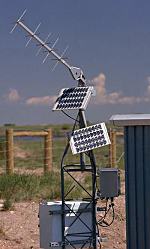
Langley’s SSE Data May Help Power Afghanistan
Solar Household Energy, Inc. (SHE) recently confirmed that enough sunlight reaches Afghanistan to power solar cookers for people without electricity.
SHE made the determination using information from Langley Research Center’s Surface Meteorology and Solar Energy (SSE) project.
“SSE data are now being used to justify putting solar cookers in Afghanistan, and we’re really excited about that,” said Paul Stackhouse, manager of the SSE project. “This study is a demonstration of how NASA research can benefit humankind in a small but tangible way.”
SHE advises private entrepreneurs on how to introduce solar cookers to developing countries and conducts research on solar energy technologies.
“SSE data are readily accessible to everyone,” said Darwin Curtis of SHE. “When a solar cooker project is proposed somewhere, the first question must be: Is there enough sun? We are only able to determine this with some certitude by consulting the NASA Surface Meteorology and Solar Energy Data Set.”
SSE scientists convert satellite data of weather and sunlight at the Earth’s surface into measurements useful to the renewable energy community. Using this information, SHE discovered that solar cookers could be used at least eight months of the year in the northern town of Mazar e Sharif and for more than 10 months in the southern town of Qandahar.
Renewable energy sources are important in Afghanistan because the majority of the country’s population does not have access to electricity. As a result, people rely upon an increasingly dwindling number of trees for firewood or costly imported fuels. Solar cookers can meet immediate energy needs at the local level while government officials create a solution to the nation’s power crisis.
“The SSE data set has great potential for a country like Afghanistan, where a large portion of their infrastructure is inoperable or has been destroyed,” Stackhouse said. “Using solar energy to provide power is a great alternative that is relatively cheap.”
Information from the SSE project could also have other benefits.
“We’re hoping that there will be a lot of uses for the data that will enable rebuilding,” Stackhouse said. “Solar and wind energy could be used to power water pumps for irrigation, and precipitation data could help officials decide which crops would grow the best in different regions.”
On June 13, 2018 the NASA’s Surface meteorology and Solar Energy (SSE) Data Archive web site was replaced with the new data web portal at https://power.larc.nasa.gov which contains improved solar and meteorology data and greatly enhanced capabilities to facilitate access to NASA’s solar insolation and meteorological data parameters.
In the first three years of operation, the number of registered users of the Web site, including major energy companies, financial institutions and federal agencies, has grown to more than 2,000 from nearly 100 countries.
 Langley Research Center’s Surface Meteorology and Solar Energy (SSE) scientists convert satellite data of weather and sunlight at the Earth’s surface into measurements useful to the renewable energy community. Using this information, Solar Household Energy, Inc. recently confirmed that enough sunlight reaches Afghanistan to power solar cookers for people without electricity.Photo courtesy of the DOE/NREL Photographic Information Exchange |



